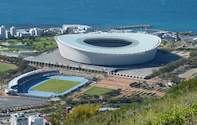The biggest sporting event in the world - the World Cup came to South Africa in 2010, and there could not have been a country more deserving, more prepared or more ready to host this spectacular event. Soccer is a culture in South Africa, so hosting the World Cup was indeed a great honour and privilege.

Prior to the Soccer World Cup, South Africa has in the past successfully managed to host numerous great sporting events, including the 1995 Rugby World Cup, the 2003 Cricket World Cup, the Women's World Cup of Golf in 2005 and the A1 GP World Cup of Motorsport in 2006.
An estimate of nearly 400 000 visitors descended onto South Africa in 2010 to watch the games live, with a few million television viewers focusing on this fast growing country.
South Africa met all the requirements needed to host this world class event, offering excellent transportation services, telecommunications, tourism and sporting infrastructure, as well as being hospitable in welcoming locals with a shared love of the beautiful game.
South Africa spent billions of Rands to improve this already world class country, including doing major upgrades and rebuilding soccer stadiums, upgrading the country airports, as well as improving the country's road and rail network. The Gautrain, a high speed rail link between Johannesburg, Sandton and O.R Tambo International Airport was also completed in time for the event.
South Africa successfully accommodated thousands of guests in 10 world class soccer stadiums, each being either newly built, rebuilt or majorly upgraded. Five of the stadiums underwent major renovations, including Soccer City and Ellis Park in Johannesburg, Loftus Versfeld in Pretoria, the Royal Bafokeng in Rustenburg and Vodacom Park in Bloemfontein.
The new stadiums which had to be built include Mbombela in Mpumalanga and the Nelson Mandela Stadium in Port Elizabeth, Eastern Cape. The Peter Mokaba Stadium in Polokwane, Kings Park in Durban and Green Point Stadium in Cape Town all had to be rebuilt. Kings Park and Green Point were turned into multipurpose sporting facilities.
But how did this grand event benefit the country? Well firstly, the tourism industry received a major boom, with nearly 400 000 visitors arriving in the country from across the world for the World Cup. Construction and engineering companies also benefited from the billions of Rands spent on infrastructure leading up to the event. This event provided thousands of jobs to a country with a high unemployment rate.
For South Africa, the World Cup was not merely a public relations strategy to show the world how great we are, but was in fact an event that had a great influence on the country at large.
Roads and public transport was improved, airports were made to a higher standard, and more jobs are now available as a result. South Africa has shown that it was capable of making a tremendous success of the world's largest sporting event, paving the the way forward for hosting major international events in future.
 Football (or soccer as we prefer to call it) is probably the biggest participation sport in the world and is certainly one of the most-watch...
Football (or soccer as we prefer to call it) is probably the biggest participation sport in the world and is certainly one of the most-watch... he 2010 Soccer World Cup in South Africa left behind a legacy of world-class sporting facilities and infrastructure. Several stadiums underw...
he 2010 Soccer World Cup in South Africa left behind a legacy of world-class sporting facilities and infrastructure. Several stadiums underw...